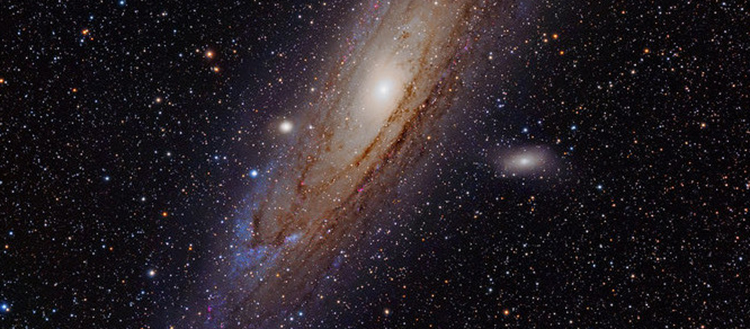The Universe is hotter than expected
Researchers at the UNIGE have succeeded in reconciling cosmological theory and observations of the Universe by considering that it is hotter than previously thought.

The Andromeda galaxy, our nearest neighbour at 2.5 million lightyears away. This galaxy along with ours and hundreds others make up the Virgo supercluster which is about 100 million lightyears in length. © DR
Astrophysicists still encounter various inconsistencies between cosmological theory and measurements made with various research instruments. Four values are particularly problematic: the speed of the expansion of the Universe today, the magnitude of matter density variations within the Universe, and the temperature variations and trajectory of the primordial light of the Universe. By no longer fixing the temperature of this light and the curvature of the Universe in their calculations, researchers at the University of Geneva (UNIGE), Switzerland, have succeeded in reconciling theory with the data. The reason? We live in an under-dense region in the Universe which slightly distorts the calculations and leads to these inconsistencies. These results, to be read in a Letter published in Physical Review D, open up new perspectives for cosmology, which would make it possible to answer many questions that are still pending.
Cosmological theorists are confronted with various inconsistencies between their computational results and satellite measurements. The first inconsistency concerns the speed of the expansion of the Universe. “We can measure this speed either through supernovae – stars that implode at the end of their lives – or through the light of the cosmic microwave background (CMB) – the electromagnetic radiation that is observed throughout the Universe”, explains Benjamin Bose, a researcher in the Department of Theoretical Physics in the Faculty of Science at the UNIGE. But these two measurements give a result that differs by more than 10% which cannot be explained by observational errors. The second inconsistency concerns the magnitude of the variation in the density of the matter in the Universe, which again differs by around 8% if calculated from the CMB or from the galaxies in the local Universe. Finally, the last two inconsistencies are statistical features of the temperature variations and light path of the CMB. In this case, theory fails to match the observations made by scientists.
A simple theory to align the results
Research is still trying to resolve these inconsistencies, albeit with a focus on one issue or the other. Benjamin Bose and Lucas Lombriser, a professor in the Department of Theoretical Physics at the UNIGE, sought to reconcile these four inconsistencies with a single theory, which would not itself introduce numerous other hypotheses to be tested. To do this, they chose to analyse the observational data that produces these inconsistencies by not assuming a particular temperature of the CMB – which is usually considered fixed – and the curvature of the Universe. “By removing these two assumptions, not only do the inconsistencies in the temperature variations of the CMB and its trajectory decrease, but those linked to the speed of the expansion of the Universe today and the spatial differences in the density of matter disappear, with measurements that are in statistical agreement!” Benjamin Bose enthuses. But how can this be explained?
The Earth may be located in a region of low density in the Universe
Lucas Lombriser hypothesised that the Earth is located in an under-dense region within the Universe when compared to the average. “This is why the measurements we make are slightly off, with the temperature of the cosmic microwave background being somewhat higher than the temperature we observe locally”, explains the Genevan professor. This hypothesis is corroborated in particular by measurements made of local galaxies, which would support the idea that the Earth is indeed in a less dense region of the Universe than the average.
According to this cosmological theory, the temperature of light would therefore be higher than that measured with our equipment and used in research. And this difference would affect the calculations and lead to these inconsistencies.
The UNIGE researchers now have to redo their data analysis on the basis that we live in a region of under-density in the Universe. “We show here that we do not need new physics to solve the scientific problems we face. It may just be a matter of taking a new point of view”, concludes Benjamin Bose.
